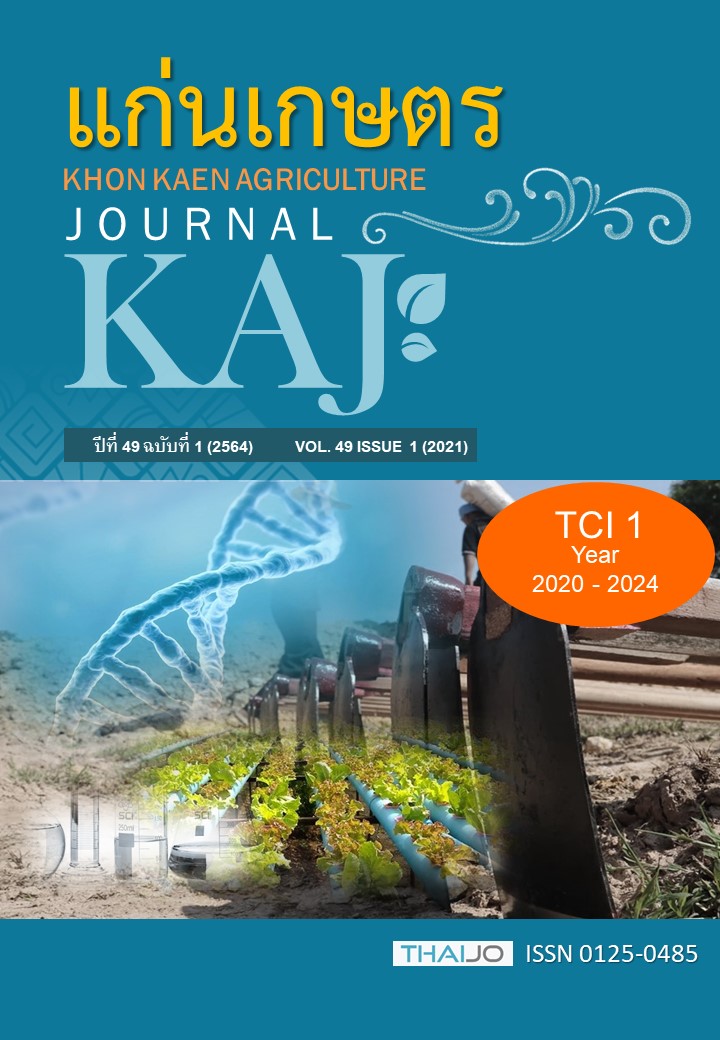การคัดเลือกเชื้อแบคทีเรียปฏิปักษ์ต่อเชื้อรา Fusarium fujikuroi สาเหตุโรคถอดฝักดาบข้าว
Main Article Content
บทคัดย่อ
การศึกษาผลของแบคทีเรียปฏิปักษ์ที่แยกได้จากดินบริเวณรอบรากข้าวต่อการยับยั้งการเจริญของเชื้อรา Fusarium fujikuroi สาเหตุโรคถอดฝักดาบของข้าว โดยจากการแยกเชื้อราสาเหตุโรคถอดฝักดาบของข้าวได้รวม 58 ไอโซเลต เมื่อทดสอบความสามารถในการก่อให้เกิดโรค พบเชื้อรา F. fujikuroi ไอโซเลต CRFuRD-7 เป็นสายพันธุ์ที่ก่อให้เกิดความรุนแรงของโรคสูงสุด เมื่อนำเชื้อดังกล่าวมาทดสอบประสิทธิภาพของเชื้อแบคทีเรียในดินที่แยกเชื้อได้จากบริเวณรอบรากข้าวโดยวิธี dual culture พบว่าเชื้อแบคทีเรียในดินบริเวณรอบรากข้าว ไอโซเลต RC-1, RR-51 และ SR-31 มีเปอร์เซ็นต์การยับยั้งเท่ากับ 46.23, 52.69 และ 53.23 เปอร์เซ็นต์ตามลำดับ หลังจากนั้นจึงทำการทดสอบการสร้างสารเมตาโบไลท์ของเชื้อแบคทีเรียทั้ง 3 ไอโซเลต คือ RC-1, RR-51 และ SR-31 พบว่าเชื้อดังกล่าวสามารถผลิตเอนไซม์เซลลูเลส อะไมเลส และสร้างไซเดอร์โรฟอร์ได้ ผลการทดสอบความสามารถของเชื้อแบคทีเรียต่อการควบคุมโรคถอดฝักดาบบนเมล็ด พบว่าสามารถลดการเกิดโรคบนเมล็ดได้ โดยกรรมวิธีแช่ด้วยสารแขวนลอยเชื้อแบคทีเรียทั้ง 3 ไอโซเลตก่อนนำไปทดสอบด้วยเชื้อราสาเหตุโรค F. fujikuroi มีเปอร์เซ็นต์การเกิดโรคเท่ากับ 39.50 36.25 และ 39.00 เปอร์เซ็นต์ตามลำดับ เมื่อเปรียบเทียบกับชุดควบคุมที่มีเปอร์เซ็นต์การเกิดโรคเท่ากับ 81.75 เปอร์เซ็นต์ จากการหาลำดับนิวคลีโอไทด์บริเวณ 16S rRNA ของเชื้อแบคทีเรียปฏิปักษ์ที่ใช้ในการทดลองนี้ พบว่าเป็นเชื้อแบคทีเรีย Bacillus amyloliquefaciens
Article Details

อนุญาตภายใต้เงื่อนไข Creative Commons Attribution-NonCommercial-NoDerivatives 4.0 International License.
เอกสารอ้างอิง
ปฏิกรณ์ อินโองการ และศิริลักษณ์ สันพา. การคัดเลือกแบคทีเรียปฏิปักษ์ที่มีประสิทธิภาพยับยั้ง Curvularia lunata เชื้อราสาเหตุโรคกล้าเน่าของข้าว. 2560. น. 103-111ใน: นเรศวรวิจัย ครั้งที่ 13: วิจัยและนวัตกรรมขับเคลื่อนเศรษฐกิจและสังคม. มหาวิทยาลัยนเรศวร
ปภัสสร สีลารักษ์ และ เพชรรัตน์ ธรรมเบญจพล. 2559. การถ่ายทอดทางเมล็ดพันธุ์ของเชื้อราฟิวซาเรียมสาเหตุโรคถอดฝักดาบของข้าวและศักยภาพของเชื้อ Streptomyces-PR15 และ Streptomyces-PR87 ในการควบคุมโรคจากเชื้อฟิวซาเรียมของพืชเศรษฐกิจ. แก่นเกษตร. 44(ฉบับพิเศษ 1): 238-245.
พีระวรรณ พัฒนวิภาส ธารทิพย ภาสบุตร และบุษราคัม อุดมศักดิ์. 2560. การคัดเลือกและทดสอบประสิทธิภาพแบคทีเรียปฏิปักษ์ในการควบคุมเชื้อรา Fusarium moniliforme สาเหตุโรคต้นเน่าของข้าวโพด. หน้า 904-911. ใน: รายงานผลงานวิจัยประจำปี 2560. สำนักวิจัยพัฒนาการอารักขาพืช กรมวิชาการเกษตร.
สายชล โนชัย และสมบัติ ศรีชูวงศ์. 2550. ประสิทธิภาพของเชื้อราปฏิปักษ์ที่แยกได้จากเมล็ดข้าว ขาวดอกมะลิ 105 ในการควบคุมโรคถอดฝักดาบต้นกล้าข้าว. วารสารเกษตร. 23: 59–66.
สำนักงานเศรษฐกิจการเกษตร. 2562. สถานการณ์สินค้าเกษตรที่สำคัญแนวโน้ม ปี 2562. สำนักงานเศรษฐกิจการเกษตร. กระทรวงเกษตรและสหกรณ์. 241 หน้า.
สุภาณี พิมพ์สมาน. 2540. สารฆ่าแมลง. คณะเกษตรศาสตร์ มหาวิทยาลัยขอนแก่น. 164 หน้า.
หนึ่ง เตียอำรุง และ นันทกร บุญเกิด. 2539. ธาตุเหล็ก ซิเดอร์โรฟอร์ และ จุลินทรีย์. วารสารเทคโนโลยีสุรนารี 3: 95-100.
อรทัย เตชะฤทธิ์. 2555. กรมการข้าวพบโรคถอดฝักดาบในแปลงนาของเกษตรกรแถบ จ.ชัยนาท. กลุ่มประชาสัมพันธ์ ศูนย์สารสนเทศ กรมการข้าว กระทรวงเกษตรและสหกรณ์. 2 หน้า.
อนันต์ วงเจริญ. 2557. การคัดเลือกเชื้อราเอนโดไฟต์จากข้าว (Oryza sativa L.) ที่มีประสิทธิภาพยับยั้งราสาเหตุโรคข้าว. แก่นเกษตร. 42: 385-396
Ahmad, F., I. Ahmad, and M. S. Khan. 2008. Screening of free-living rhizospheric bacteria for their multiple plant growth promoting activities. Microbiological Research. 163: 173-181.
Amatulli, M. T., D. Spadaro, M. L. Gullino, and A. Garibaldi. 2010. Molecular identification of Fusarium spp. associated with bakanae disease of rice in Italy and assessment of their pathogenicity. Plant Pathology. 59: 839-844.
Burr, B., F. A. Burr, K. H. Thompson, M. C. Albertsen, and C. W. Stuber. 1988. Gene mapping with recombinant inbreeds in maize. Genetics. 118: 519–526.
Chauraria, B., A. Pandey, L. M. S. Palni, P. Trivedi, B. Kumar, and N. Colvin. 2005. Diffusible and volatile compounds produced by an antagonistic Bacillus subtilis strain cause structural deformations in pathogenic fungi in vitro. Microbiological Research. 160: 75-81.
Chung, E.J., M. T. Hossain, A. Khan, K. H. Kim, C. O. Jeon, and Y. R. Chung. 2015. Bacillus oryzicola sp. nov., an endophytic bacterium isolated from the roots of rice with antimicrobial, plant growth promoting, and systemic resistance inducing activities in rice., The Plant Pathology Journal. 31: 152–164.
Gond, S. K., S. B. Marshall, S. T. Mònica, and F. W. J. James. 2015. Endophytic Bacillus spp. produce antifungal lipopeptides and induce host defense gene expression in maize. Microbiological Research. 172: 79-87.
Gupta, A. K., I. S. Solanki, B. M. Bashyal, Y. Singh, and K. Srivastava. 2015. Bakanae of rice -an emerging disease in Asia. Journal Animal Plant Science. 25: 1499-1514.
Gupta, P., S. Sahai, N. Singh, C. Dixit, D. Singh, C. Sharma, M. Tiwari, R. Gupta, and S. Garg. 2004. Residue burning in rice-wheat cropping system: causes and implications. Current Science. 87: 1713-1717
Hossain, M.T., A. Khan, E.J. Chung, M.H. Rashid, and Y. R. Chung. 2016. Biological control of rice bakanae by an endophytic Bacillus oryzicola YC7007. Plant Pathology Journal. 32: 228- 241.
Imura, J. 1940. On the angles between blades and culms in the accelerated rice seedlings caused by Gibberella fujikuroi. Annals of the Phytopathological Society of Japan. 10: 45– 48.
International Seed Testing Association. 2019. Detection of Alternaria dauci in Daucus carota (carrot) seed by blotter method. ISTA Rules 2020 Chapter 7 Seed Health Testing International Seed Testing Association, Bassersdorf, Switzerland.
Jeon, Y.A., S.H. Yu, Y.Y. Lee, H.J. Park, S. Lee, J.S. Sung, Y.G. Kim, and H.S. Lee. 2013. Incidence, molecular characteristics and pathogenicity of Gibberella fujikuroi species complex associated with rice seeds from Asian countries. Microbiology. 41: 225-233.
Kazempour, M. N., and S. A. Elahinia. 2007. Biological control of Fusarium fujikuroi, the causal agent of bakanae disease by rice associated antagonistic bacteria. Bulgarian Journal of Agricultural Science. 13: 393-408.
Luo, J. Y., G.L. Xie, B. Li, Y.C. Luo, L.H. Zhao, X. Wang, and B. Liu. 2005. Gram-positive bacteria associated with rice in China and their antagonists against the pathogens of sheath blight and bakanae disesase in rice. Rice Science. 12: 213-218.
Mardanova, A. M., G. F. Hadieva, M. T. Lutfullin,I. V. Khilyas, L. F. Minnullina, A. G.Gilyazeva, L. M. Bogomolnaya, and M. R. Sharipova. 2017. Bacillus subtilis strains with antifungal activity against the phytopathogenic fungi. Agricultural Sciences. 8: 1-20.
Matic, S., D. Spadaro, A. Garibaldi, and L. M. Gullino. 2014. Antagonistic yeast and thermotherapy as seed treatments to control Fusarium fujikuroi on rice.Biological Control. 73: 59-67.
Ou, S. H. 1985. Rice diseases. Commonwealth Mycological Institute, Slough, UK. 371 p.
Pane, C., and M. Zaccardelli. 2015. Evaluation of Bacillus strains isolated from solanaceous phylloplane for biocontrol of Alternaria early blight of tomato. Biological Control. 84: 11- 18.
Rosales, A. M., and T. W. Mew. 1997. Suppression of Fusarium moniliforme in rice by rice-associated antagonistic bacteria. Plant Disease. 81: 49-52.
Sunder, S., and Satyavir. 1997. Survival of Fusarium moniliforme in soil enriched with different nutrients and their combinations. Indian Phytopathology. 50: 474-481.
Sun, S.K. and W.C. Snyder. 1981. The bakanae disease of the rice plant. In: Fusarium: Diseases, Biology and Taxonomy. The Pennsylvania State University. 104-113.
Webster, R.K. and P.S. Gunnell. 1992. Compendium of rice disease. First edition, The American Phytopathological Society Press. St. Paul, Minnesota, USA. pp: 86.
Weising, K., H. Nybom, K. Wolff, and W. Meyer. 2000. DNA fingerprinting in plants and fungi. CRC Press.
322 p.
White, T. J., T. Bruns, S. Lee, and J. W. Taylor. 1990. Amplification and direct sequencing of fungal ribosomal RNA genes for phylogenetics. In: Innis MA, Gelfand DH, Sninsky JJ, White TJ, eds. PCR protocols: a guide to methods and applications. New York: Academic Press. p 315-322.
Vessey, J. K. 2003. Plant growth promoting rhizobacteria as biofertilizers. Plant and Soil. 255: 571-586.
Zhao P., C. Quan, Y. Wang, J. Wang, and S. Fan. 2014. Bacillus amyloliquefaciens Q-426 as a potential biocontrol agent against Fusarium oxysporum f. sp. Spinaciae. Journal Basic Microbiology. 54: 448–456.
Zimand, G., L. Valinsky, Y. Elad, I. Chet, and S. Manulis. 1994. Use of the RAPD procedure for the identifcation of Trichoderma strains. Mycological Research. 98: 531-534.


